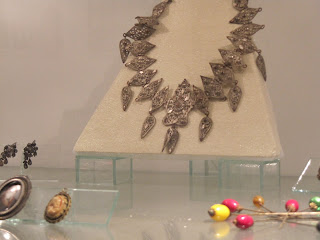My Novi Sad host grandparents who lived in a farmhouse in Čerević raised their own animals for food and profit: a goat, cow, and a few chickens. This is still very common in villages in Serbia and it mirrors the traditional way of living.

This guy was our tour guide for the museum about traditional Serbia and Romuliana and when we showed an interest in a certain flute on display, he came out with a similar one and began tooting away.

Kitchen set-up

Jewelry of the affluent

Shoes

Clothes


Southern Serbian traditional garments with Turkish influence

Often waiters and waitresses at kafanas will be dressed in traditional garments. This Belgrade kafana, which our group fondly refers to as "red roof" because of its, well, red roof, serves delicious food with a traditional interior and exterior.

Earthenware! This was taken in Macedonia. These clay pots for cooking and serving food are found throughout the Balkans.

No comments:
Post a Comment